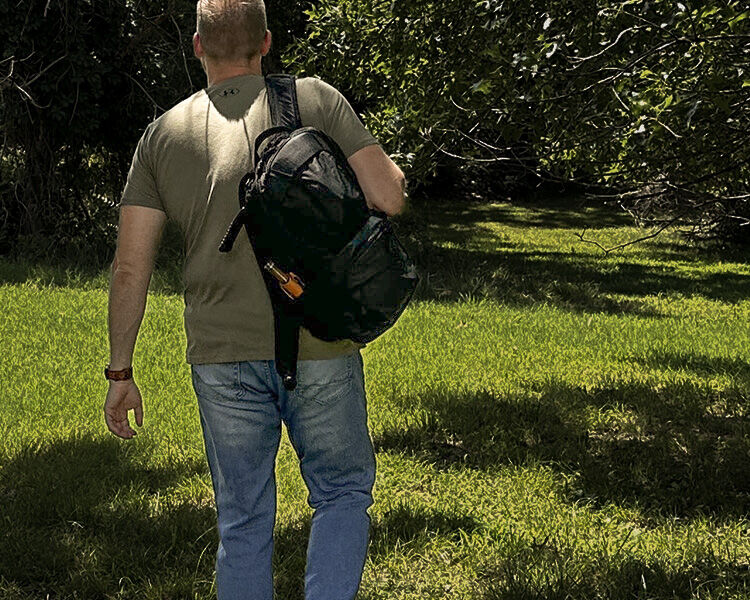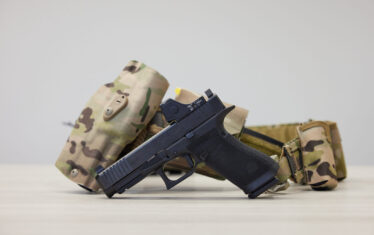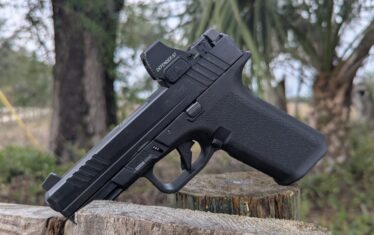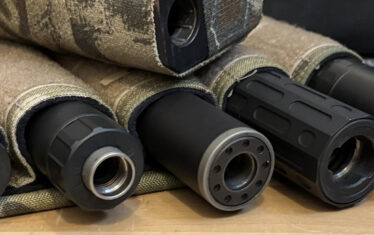It’s a peaceful day at work and you’re enjoying your mid-morning coffee, when suddenly, you hear the unmistakable moan of zombies. Yep, the apocalypse is here, and those undead folks aren’t just there for the donuts! You have watched every episode of “The Walking Dead,” so you know a quick drive home isn’t going to happen. But that’s ok because you have a well-packed get-home-bag ready to go, right?
Ok, we all know a zombie apocalypse isn’t going to happen, probably… But there are several types of incidents that can make it difficult to get back home. This could be a natural disaster, terrorist attack, civil unrest, or a dozen other things you never thought possible.
American poet Maya Angelou once said, “Hoping for the best, prepared for the worst, and unsurprised by anything in between.” With a career in law enforcement, that quote is a part of my daily life. Almost every day I’m surprised by the outcome of some call or event. I’m also surprised at how many people are not prepared for even the smallest incident.
A Get Home Bag isn’t just for those doomsday-type incidents, it’s perfect for everyday life as well. I’ve been carrying a get-home bag in my vehicle for years now. Here are some tips and ideas for putting one together, based on my own experience.
Why a Get Home Bag?
I’m sure you have heard of a “go-bag” or “bug-out-bag” before, which is a bag designed for leaving the house quickly. But we often overlook the fact that we may need a bag designed for getting us back home, too.
In the era of Uber rides and instant delivery, we often overlook how reliant we are on modern conveniences. We daily travel miles away from home daily, hardly giving a thought to what we’d do if the unexpected happened. What happens if your car breaks down in the middle of nowhere, or a natural disaster strikes while you’re out?
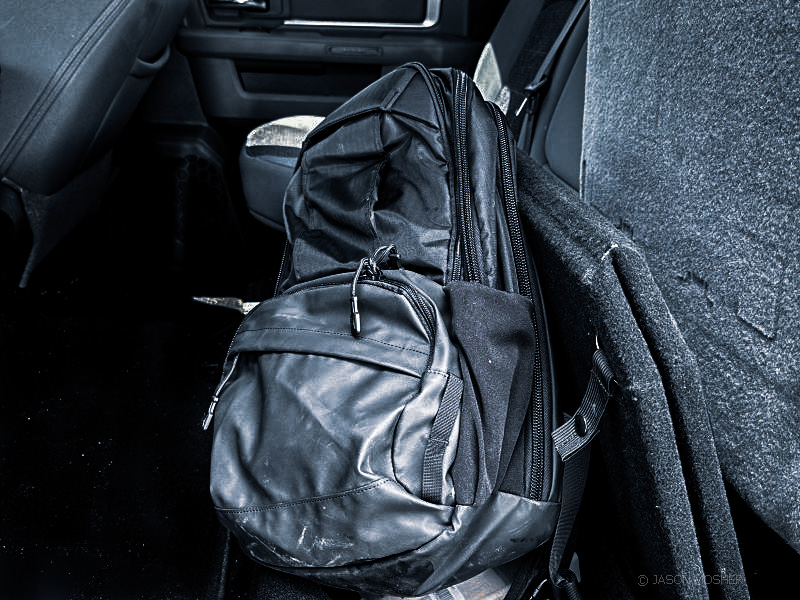
I regularly travel to a larger city that is about an hour’s drive from my home town. What happens if I become stranded there and traveling in a vehicle is no longer an option?
Years ago, I was on duty when that town was hit by a large tornado. It gave me a first-hand look at how fast a world can be turned upside down. In that area, phones stopped working, and entire city blocks were gone, making it hard to figure out where you were even at. Roads were no longer visible and for a short time, panic and confusion took over. If this were to happen on an even larger scale, traveling on foot for any significant distance may prove difficult.
This is why will not travel anywhere without my get-home bag.
What type of backpack is best for a Get Home Bag?
Choosing the right bag is like picking the right car for a road trip. You want something durable, comfortable, and capable of holding all your essentials without breaking your back.
The tricky part however is finding that perfect size for you. I started with a large backpack to make sure I had plenty of room. Have you heard the saying “if you build it they will come?” It turns out the same concept works with extra space in backpacks. If you have it, you will use it.
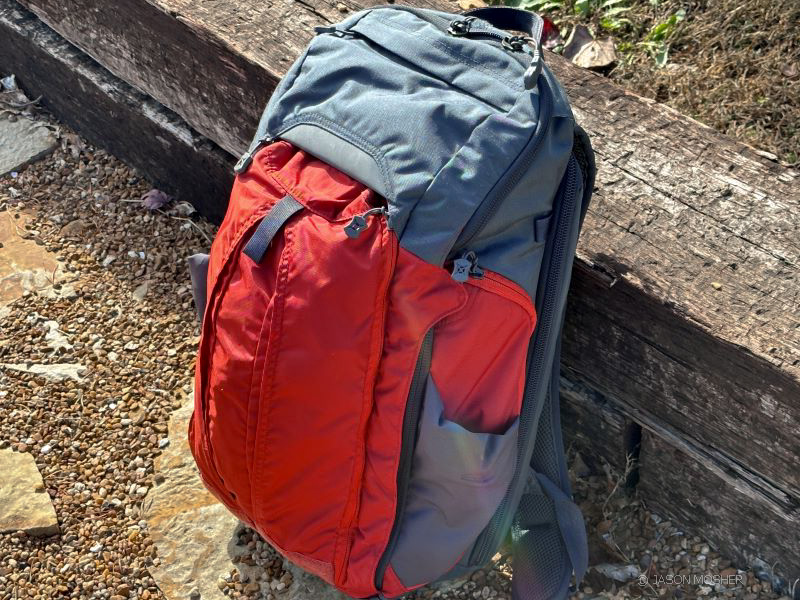
My bag got so heavy it wasn’t practical to haul around from one car to the next. I downsized a little which forces me to be more selective of what I pack in the bag.
A get-home bag does not have to be backpack, but it’s going to be the easiest to carry with you. Here are some that I own and use regularly.
Vertx Ready Pack
Vertx is one of my go-to brands for backpacks. They are built extremely well and I like the way they set up the pockets. Some of their bags also have removable Velcro pockets so you can customize the bag to your own liking.
The Ready Pack is a 20-liter backpack made from durable nylon. It features multiple compartments for organization and concealed carry compartment. It retails for $150
Vertx Base Camp Backpack
The Vertx Base Camp is a larger option with a 35-liter capacity. It’s taller, which makes it easy to pack a lot of different gear in. It has heavy-duty zippers and a belly band to help with long journeys. This is about as large as I go for a get-home bag, but it holds everything I need. The retail price is about $200.
5.11 Covert Backpack
The 5.11 Covert Backpack offers ample storage and doesn’t look like a “survival bag.” It includes a reinforced handle, quick-access pockets, and is made from water-resistant materials. It also features a hidden compartment for personal protection equipment. You can find it for about $120.
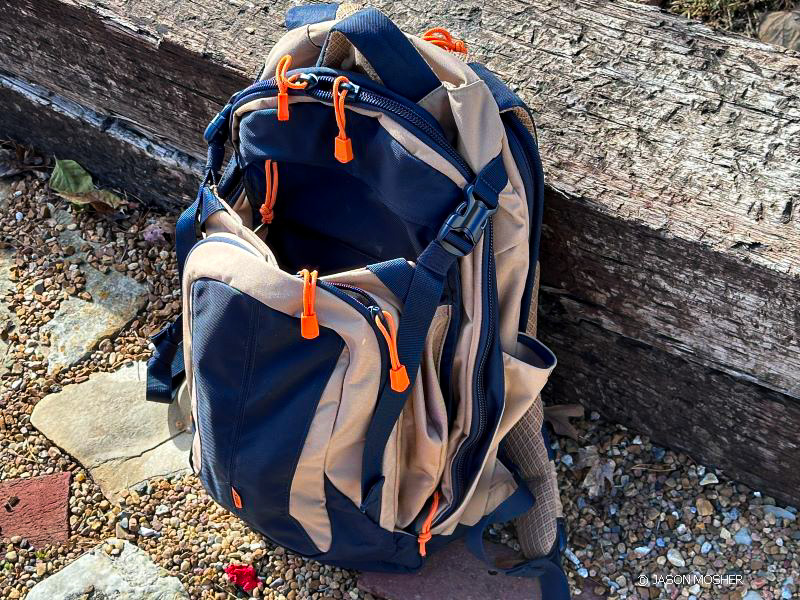
Under Armor Hustle Backpack
The Under Armor Hustle Backpack is a versatile 24-liter bag designed for multi-purpose use. It features a water-resistant finish, multiple zippered pockets, and a padded sleeve that fits up to a 15-inch laptop.
When using this as a get-home bag, I placed a map, emergency blankets, and other items in the lap-top compartment. I’m not sure this bag would hold up to extended use like the others above, but for the price, it’s a great option. It can be found in most retail stores for about $55
What To Put In Your Get Home Bag
Now that you’ve chosen your bag, it’s time to pack it. This is the part that starts out as fun and turns frustrating. When you start thinking of everything you need during an emergency, the list will get longer than the room in your bag.
Everyone’s list will be a little different. Deciding what to pack depends some on where you live, how far you regularly travel, and what you are comfortable using.
Think of this as your lifeline in a pinch, so the items should be practical, lightweight, and essential. Here’s a list of common items I pack in my get-home bag.
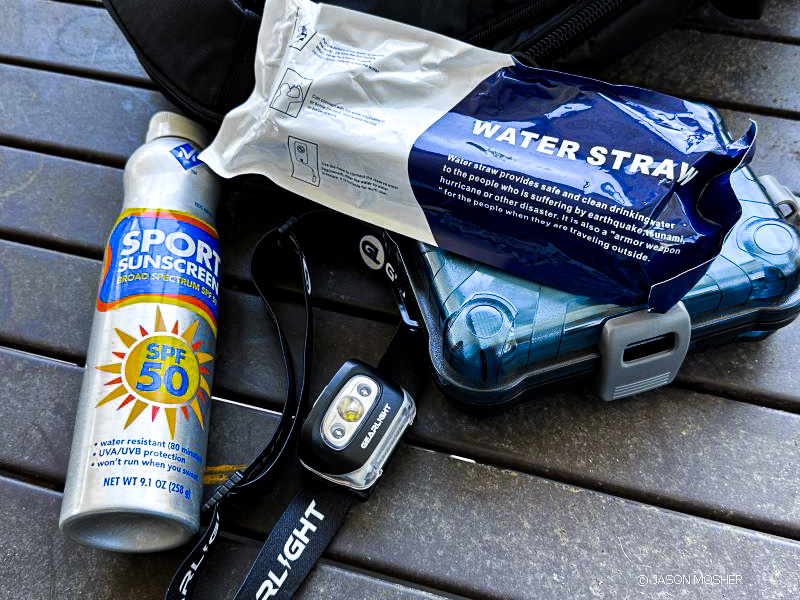
Quick Access Compartment
Your quick-access compartment should be filled with items that you’ll use more often, or that you may need to access in a hurry. Here are a few of the basics.
Water and Filtration
Water is among the most important items to have, but it’s also heavy. I use water pouches with a 5-year shelf life. I also keep a filter straw and a small bottle of purification tablets in the bag. I also keep water pouches in between the seats of my car to provide a little extra water.
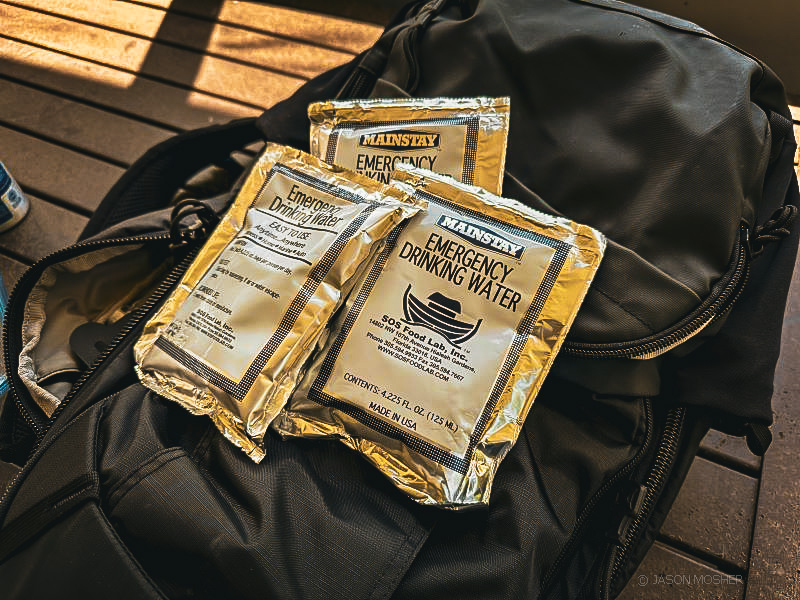
Food
Non-perishable items like energy bars, trail mix, and jerky are great to have in your bag. You don’t need to have a full meal, but you may need some energy. To some degree, the amount of food you pack will depend on the distance you travel from home. You’re looking for high-calorie, lightweight options.
First Aid Kit
A basic kit should be in every car and travel bag. At the least, it should include bandages, antiseptic wipes, pain relievers, a tourniquet, gauze, and a couple of rolls of self-sticking bandage wrap. Tweezers, assorted band-aids, and some sunscreen are great. While this is for emergency use as well, the medical supplies are great for everyday use.
Clothing
A change of clothes, preferably moisture-wicking and weather-appropriate, is good to pack. A good rain jacket goes a long way. Don’t forget extra socks and underwear. Also keep in mind what type of shoes you wear. If it’s freezing out, comfy sneakers will get awfully cold. Keep some boots in your car next to your bag.
Larger Storage Compartments
These items are a bit more substantial and will prove beneficial if you’re out for an extended time or need to travel some distance.
Shelter
A lightweight tarp or emergency bivy sack is worth the money. You might need to spend a night outdoors and you would be surprised how handy a small tarp can be.
Fire Starting Tools
Waterproof matches, a lighter, and a small fire starter kit do not take up much room. Throw it in there just in case you need it. Even if you don’t live in the boonies, a warm fire can make the difference between life and death in some cases.
Navigation
Just about everyone relies on cell phones for navigation now. If your phone doesn’t work, a good compass and map will be your best friend. Knowing how to read a map is a life skill so practice every now and then.
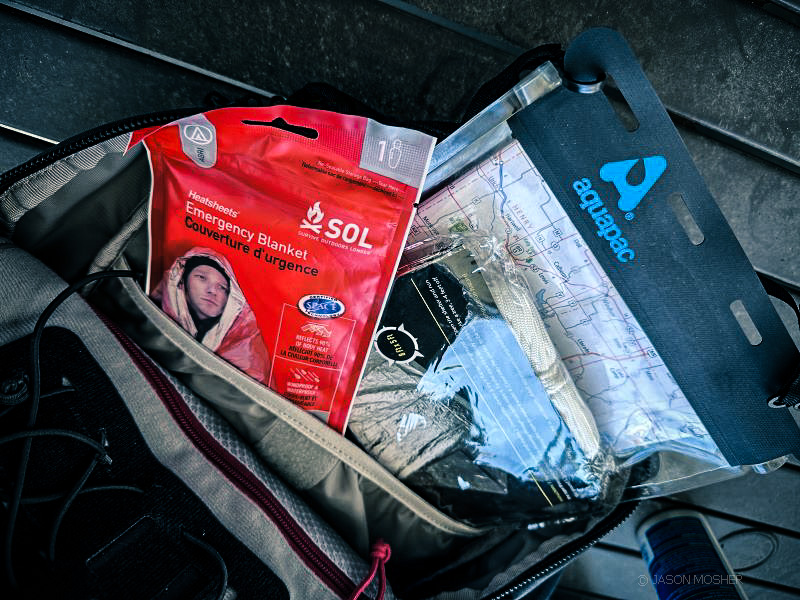
Multi-tool
A versatile multi-tool can handle a variety of tasks, from cutting to opening cans. Stick one in the bag or have it in the car ready to grab.
Flashlight
Preferably a headlamp for hands-free use, with extra batteries. Most people never think to keep a headlamp on them, but in emergencies, you may need both hands.
Personal Protection
Depending on your comfort level and local laws, consider pepper spray, a knife, or even a compact firearm. I carry a concealed firearm on me at all times, but I also like to keep an extra firearm in my get-home bag.
Additional Items to Consider
Communication
A fully charged power bank and a small, durable radio or combo of the two is a must. If something happens who’s to say you even know what the emergency is? Being able to turn on the emergency broadcast station is helpful. I have one that is a radio, light, power bank and recharges with a hand crank.
Cash
Small bills and coins are good to have on hand. In an emergency, digital payment methods might not work so keep just a little cash in case you need it. Remember, the bag is for any size or type of emergency. Losing your wallet on a trip is a small emergency.
Hygiene Items
Keep some hand sanitizer, wet wipes, a bar of soap and a roll of toilet paper in your bag.
Specialty Items
Depending on your personal needs, this could include glasses, contact solution, medications, a compact fishing kit, or other survival tools specific to your environment.
Be Prepared, Not Paranoid
Packing a get home bag isn’t a one-and-done deal. It should be evaluated on a regular basis to ensure it stays in working order and up to date.
Here’s how to keep your GHB ready:
Check expiration dates on the food, water, medications, and batteries. I like to do this every quarter and replace anything that will expire within 6-months. I check the batteries to make sure they’re working but replace them once per year regardless.
Update your clothing and gear based on the season. Summer might require sunblock and a hat, while winter needs warmer clothing, gloves, and warm boots. It’s a little work but take 30 minutes of your day once per spring and fall to switch things around.
Test your gear periodically to make sure everything is functioning. If you like to go camping or hiking, take your gear with you and use it. It’s better to find issues in a controlled test than during an emergency.
Peace of Mind
A Get Home Bag is a smart investment in your personal safety and peace of mind. It’s not about being paranoid; it’s about being prepared. Life is unpredictable, and having a GHB ensures that you’re ready for whatever it throws at you.
Whether you’re dealing with zombies, natural disasters, or a flat tire, your get home bag will make your day a little better. So, get packing, stay safe, and may your journey home always be a smooth one.





